Lesson 1 世界の「こんにちは」を知ろう - Greetings of the world
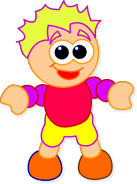 使用表現(target English):What's your name? My name is Ken. Nice to meet you.
使用表現(target English):What's your name? My name is Ken. Nice to meet you.
第一時:世界には様々な挨拶があることを知る。
First hour: Learn that there are different greetings in the world.
第二時:挨拶のマナーを知り、積極的に挨拶し、自分の名前を言う。
Second Hour: Learn manners of greetings, to do greetings with a positive
attitude and be able to say your own name.
![]() 『What's your name?』 Song & Lesson plan
『What's your name?』 Song & Lesson plan
第三時:友達と挨拶をし、作成した名刺を交換する。
Third hour: Greet your friends. Name card exchange game.
![]() Name care Game
Name care Game
※Apart from the rather large amount of time they recommend for this the
biggest problem is having to discriminate between "Japanese"
kids who should use their surname first, and "non-Japanese" kids
who should do it the other way round. I find this very uncomfortable so
I'd recommend just using the first name for everyone.
It might seem strange having different world greetings in the first lesson
(it's a bit like learning Japanese and saying "OK kids, everyone "Bonjour").
But I guess it shows the emphasis is still on "international Understanding"
rather than English.
Lesson 2 ジェスチャーをしよう Gestures
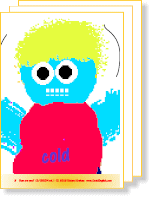 使用表現( target phrases):How are you? I'm happy.
使用表現( target phrases):How are you? I'm happy.
第一時:様々な感情や様子を表す語を知り、そのジェスチャーを進んでしようとする。
First Hour: Learn about feelings and gestures
![]() How are you? Lesson Plan
How are you? Lesson Plan
![]() How are you? Picture Book
How are you? Picture Book
第二時:ジェスチャーの大切さを知り、ジェスチャーを交えて思いを伝えようとする。
Second Hour: Learn that gestures are important. Communicate using gestures.
![]() Feelings Frenzy Game
Feelings Frenzy Game
第三時:ジェスチャーを交えて、進んで相手に伝えようとする。
Third Hour: Using gestures communicate with partners.
![]() Gokiburi Game
Gokiburi Game
第四時:感情や様子を、ジェスチャーを交えて表現し、伝える。
Fourth Hour: Using gestures to communicate feelings. (I'm not sure what
the difference between these lessons is)
Lesson 3 数で遊ぼう - playing with numbers
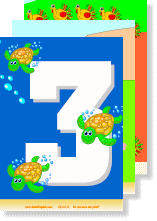 使用表現(target phrases):How many? Five.
使用表現(target phrases):How many? Five.
第一時:世界には様々な数の数え方があることを知るとともに、0から10までの数を言う。
First Hour: Learn that there are several ways of counting in the world.
Numbers from 0 to 10.
![]() Numbers Song
Numbers Song
![]() Rock, Paper, Scissors song (huge hit with the kids!)
Rock, Paper, Scissors song (huge hit with the kids!)
![]() Heads, Shoulders, Knees, Toes - Genki English Dance Version!
Heads, Shoulders, Knees, Toes - Genki English Dance Version!
![]() How old are you? Lesson planと"How many?" Song
How old are you? Lesson planと"How many?" Song
![]() Timebomb Game
Timebomb Game
![]() How old are you? Picture Book
How old are you? Picture Book
第二時:世界には様々な数の数え方があることを理解し、0から20までの数を言う。
Second Hour: Understand different ways of counting from around the world.
Say numbers 0 to 20.
![]() 13~20 Song
13~20 Song
![]() Snakes & Ladders Game
Snakes & Ladders Game
第三時:幾つか尋ねたり、0から20までの数で答えたりする。
Third hour: Asking "how many?"
![]() "How many?" Song
"How many?" Song
第四時:数を扱ったゲームを友だちと行う。
Fourth Hour: Game using numbers.
![]() Secret Code Game
Secret Code Game
※They recommend teaching numbers 1 to 10 here. I'd still stick to 1 to
12, but as they do 1 to 20 straight afterwards it's not such of a big problem.
Lesson 4 自己紹介をしよう - Self introductions
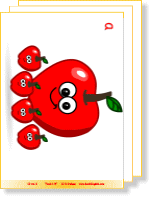 使用表現(target phrases):Do you like apples? Yes, I do./No, I don't. I like bananas. Thank you.
使用表現(target phrases):Do you like apples? Yes, I do./No, I don't. I like bananas. Thank you.
第一時:好き嫌いについて聞き取る。
First Hour: Listen to what people like or dislike
![]() Do you like...? Lesson Plan。
Do you like...? Lesson Plan。
![]() Japanese kids know half the New York Times!
Japanese kids know half the New York Times!
![]() Do you like..? Picture Book
Do you like..? Picture Book
第二時:自分の好き嫌いを相手に伝える。
Second Hour: Tell a partner what you like and dislike.
![]() I like everything Game
I like everything Game
第三時:友達の好き嫌いを確認する。
Third Hour:: Check what things your friends like and dislike.
![]() What do you like bingo? Game
What do you like bingo? Game
第四時:自分の好きなものを含めて、自己紹介する。。
Fourth Hour: Introduce yourself including things you like and dislike.
![]() I like pink fish Game
I like pink fish Game
※Again they are recommending four lessons for this. They are also using
fruits as an example for 5th graders. I think we'd be better using famous
sports stars or video games, but if you have to stick to the content then
the Genki English song livens it up a lot.
Lesson 5 いろいろな国の衣装を知ろう Clothes from different countries
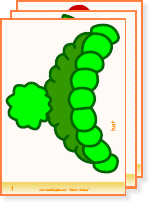 使用表現(target phrase):I don't like blue.
使用表現(target phrase):I don't like blue.
第一時:世界には様々な衣服があることを知り、その衣服の英語での言い方を知る。
Hour One: Learn that there are different clothes around the world. Learn
how to say them in English.
![]() "Baby Monkey's Winter Clothes" or Summer Clothes
"Baby Monkey's Winter Clothes" or Summer Clothes
![]() Shapes "Your blue skirt with hearts is very cute. I like that yellow star."
Shapes "Your blue skirt with hearts is very cute. I like that yellow star."
![]() Winter Clothes Picture Book
Winter Clothes Picture Book
第二時:自分の意見をはっきり言うことの大切さに気付くとともに、衣服を買うときの表現を知る。
Hour Two: Notice that it is important to express our opinion. Learn expressions
for buying clothes.
![]() How much?とBigger, please Lessons
How much?とBigger, please Lessons
![]() What do you think of? or Colours Song
What do you think of? or Colours Song
第三時:好みをはっきり言ったり、相手が気持ちよく買い物できるように声をかける。
Hour Three: Clearly express what you like. Help people to shop.
第四時:聞き手に自分が買ったものが正しく伝わるように発表する。
Hour Four: Correctly express what you have bought.
※Again I'm uncomfortable with the whole "this country's people wear
this" type of lesson, so personally I try and keep it as neutral as
possible. One good idea here is to do an exchange project with kids in other countries. The kids love it, although the teachers
may be a little upset about how many people wear T-shirts and jeans!
Lesson 6 外来語を知ろう - Loan words
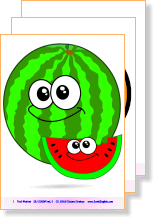 使用表現(target phrase):What do you want? Melon, please.
使用表現(target phrase):What do you want? Melon, please.
第一時:外来語とその由来の語との発音の違いに気付き、注意して発音しようとする。
Hour one: Understand the difference between "gairigo" (loan words)
and English pronunciation.
![]() Do you like? Theme
Do you like? Theme
![]() What's your favourite food? Picture Book
What's your favourite food? Picture Book
第二時:相手から尋ねられた際、自分の欲しいものを相手に頼むことができる。
Hour Two: When asked express what you would like.
![]() What would you like for breakfast?とBad Fruits Game
What would you like for breakfast?とBad Fruits Game
第三時:欲しいものを尋ねたり要求したりして、自分のフルーツパフェを作る。
Hour Three: Order what you would like and make your own fruit parfait
![]() Fruit Market Song
Fruit Market Song
第四時:作ったフルーツパフェを紹介する。
Hour Four: Present your fruit parfait to the class
※I'm not too sure about their target phrases here. You can however use
these as a great confidence booster for the kids, see "Curing the wakaranai problem"
Lesson 7 クイズ大会をしよう - Big Quiz
 使用表現(target phrase):What's this? It's a pencil.
使用表現(target phrase):What's this? It's a pencil.
第一時:同じものの英語名と日本語名(漢字の表記)との違いの面白さに気付く。
Hour One: Notice how interesting it is that the same thing has a different
name in English and Japanese (written in kanji)
第二時:"What's this?"の質問に対して、何について尋ねられているか理解し、答える。
Hour Two: Understand "What's this?" and answer.
![]() Fruit Market& Creepy Crawlies have the "What's this?" question
Fruit Market& Creepy Crawlies have the "What's this?" question
第三時:動物の英語名を知る。
Hour Three: Learn names of animals in English
![]() Do you like animals?
Do you like animals?
![]() Do you have any pets?
Do you have any pets?
第四時:友だちと互いに尋ねたり答えたりして、クイズ大会を楽しむ。
Hour four: Enjoy a "big quiz" with your friends
![]() Jeopardy Game
Jeopardy Game
![]() Around the world Game
Around the world Game
Lesson 8 時間割を作ろう - Make a timetable
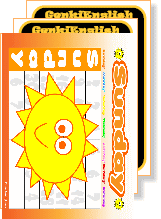 使用表現:I study Japanese.
使用表現:I study Japanese.
第一時:外国の小学校では、どのようなものが学習されているかを知るとともに、教科の英語名を知る。
Hour One: Learn what kids in foreign countries learn in school. Learn names
of subjects in English.
![]() School Subjects
School Subjects
第二時:教科名や曜日を扱ったゲームを積極的にする。
Hour Two: With a positive attitude play a game using days of the week and
subject names.
![]() Days of the Week
Days of the Week
第三時:作成した自分のオリジナル時間割を友だちに伝える。
Hour Three: Tell your friends about your original timetable that you have
made.
第四時:既習事項を扱ったクイズ大会に積極的に参加し、自分たちの考えを発表する。
Hour Four: Review quiz. Present your thinking to the class. ( I don't know
what that means either)
※ This could be quite a good lesson for 5th graders. They also show the
Chinese versions of characters for subjects, and they compare timetables
in China, Australia and Japan which is cool. The only problem I have here
is the phrase "I study..." which may sound OK for Japanese or
English, but kids in grade school can't say "I study PE." I just
go with the international phrase which is "I have Japanese/English/PE
etc," although you might need a little tact when suggesting there
is a mistake in the book!
Lesson 9 ランチメニューを作ろう Make a lunch menu
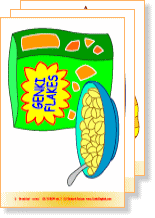 使用表現(target phrases):What would you like? I'd like fruits.
使用表現(target phrases):What would you like? I'd like fruits.
第一時:日本と外国とでは、朝食時に食べるものが異なっていることを知る。
Hour One: Learn that foreign countries' breakfasts are different to Japan.
(Yes, that is what it says! And here was me thinking that some people in
Japan eat cereal or toast...)
![]() What would you like for breakfast? & School Lunch Exchange
What would you like for breakfast? & School Lunch Exchange
第二時:食べ物や料理を表す語を知る。
Hour Two: Learn food and cooking phrases. (Not only English judging by
the picture cards)
![]() Mr. Monkey's Cooking Corner
Mr. Monkey's Cooking Corner
第三時:丁寧な表現で尋ねたり、自分の欲しいものを伝えたりする。
Hour Three: Using polite language ask for things you'd like.
![]() What would you like for breakfast?
What would you like for breakfast?
第四時:友だちの好みを聞き、スペシャル・ランチを作る。
Hour Four: Ask your friends what they like and make a "special lunch"
※ Is it just me or does "I'd like fruits" sound strange? I'm
not too keen on this "let's learn how different Japan is" attitude
in this theme but it's a good excuse to make foods, and the breakfast videos make it really international.
Here's my article about teaching 6th graders.
※ I don't really understand what they want to do here. Although it's good that they are introducing the alphabet after some speaking, it's a shame that they are doing it the Japanese way round (i.e. in Japan romaji is mainly used for computer keyboards hence capital letters first). Usually when teaching English you introduce lower case letters first, because there are so many of them on a page. Also I'm trying to find out what they mean by "yomikata" it could mean the sound of the letters (i.e. phonics) or many teachers could take it as learning the names of letters in Japanese i.e. ay, bee, she etc. In any case as there is lots of time I'd go for phonics, it has been proven to really improve students' scores.
Lesson 2 いろいろな文字があることを知ろう - Learn that there are lots of characters
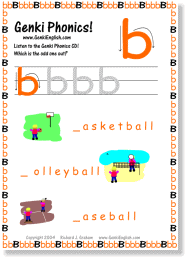 使用表現(target phrase):What's this?
使用表現(target phrase):What's this?
第一時:世界の様々な文字に興味を持ち、アルファベットには小文字もあることを知るとともに、20以上の数を言う。
Hour One: Have an interest in the different characters of the world. Learn
that the alphabet also has lower case letters (does this assume the kids
didn't know that until now?). Learn numbers above 20.
第二時:アルファベットの小文字に興味を持ち、読み方と小文字を一致させる。
Hour Two: Be interested in lower case letters. Learn how to read them.
![]() Online phonics gamesとphonics/alphabet worksheetsは役に立ちます。
Online phonics gamesとphonics/alphabet worksheetsは役に立ちます。
第三時:自らアルファベットの文字を読み、小文字と読み方とを一致させる。
Hour Three: Read the lower case letters.
第四時:身の回りにあるアルファベット表示に興味を持ち、アルファベットの大文字と小文字を書き写す。
Hour Four: Be interested in the Roman letters you see around. Copy lower
case and upper case letters.
※ With "What's this?" in this lesson, it sounds like they've
just directly translated the Japanese "Kore wa nani?" without
thinking about the English. How do you answer it? "It's the letter
a?". I'm not sure.
Lesson 3 カレンダーを作ろう Make a calendar
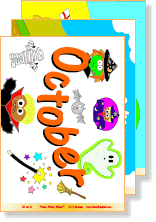 使用表現(target phrases): When is your birthday? My birthday is March third.
使用表現(target phrases): When is your birthday? My birthday is March third.
第一時:日本の行事や特徴を確認し、行事の行われる月の言い方を知る。
Hour One: Review Japanese monthly events & characteristics. Learn the
month that each event is in.
第二時:自分の誕生日を言う。
Hour Two: Say your own birthday
![]() When is your birthday? Lesson Plan
When is your birthday? Lesson Plan
第三時:月日について尋ねたり答えたりして、誕生日カレンダーを作成する。
Hour three: Ask and reply about dates & months. Make your own birthday
calendar
第四時:作成した誕生日カレンダーをもとに、誕生月を紹介する。
Hour Four: Using your calendar, introduce the month you were born.
※I always find this strange that you are learning about English months,
but using Japanese festivals to illustrate them. Imagine a school in the
US saying "Let's learn the months of the year in Japanese! Right,
everybody say "in July we have Independence Day". Surely if you're
learning Japanese you learn about Japanese events? If you're learning English
you learn about English speaking countries events?
Lesson 4 できることを紹介しよう - Introduce things you can do.
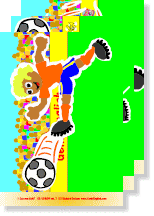 使用表現(target phrases):Can you swim? Yes, I can./No, I can't. I can swim.
I can't swim.
使用表現(target phrases):Can you swim? Yes, I can./No, I can't. I can swim.
I can't swim.
第一時:相手の話を積極的に聞き、何ができ、何ができないかを理解しようとする。
Hour One: With a positive attitude ask and understand what your friends
can and can't do.
![]() Superhero, I can ... & Can you speak...?
Superhero, I can ... & Can you speak...?
![]() I can do it? & Can I play? Lesson Plan。
I can do it? & Can I play? Lesson Plan。
![]() Can you do it? Picture Book
Can you do it? Picture Book
![]() What can you see? Theme
What can you see? Theme
第二時:質問に答えて、自分のできることと、できないこととを伝えようとする。
Hour Two: Answer the question with what you can and can't do.
第三時:友達と、どのようなことができるのかを尋ねたり答えたりする。
Hour Three: Ask and answer what you can and can't do with friends.
第四時:自分のできることを発表したり、友達の発表を理解したりする。
Hour Four: Present what you can and can't do. Understand what your friends
present.
※ This is a really important theme! They use birds here to illustrate the
point. eg. a penguin can't fly but it can swim. Nice idea and it fits in
very well with the new Superhero, I can .... song to make it a bit more interesting for the kids.
Lesson 5 道案内をしよう - Street Directions
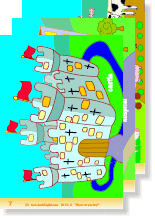 使用表現(target English):Where is the flower shop? Go straight. Turn right/left. Stop.
使用表現(target English):Where is the flower shop? Go straight. Turn right/left. Stop.
第一時:街中にある様々な建物の英語での言い方に興味をもち、理解しようとする。
Hour One: Learn and understand names of buildings in town
![]() Where are you going? and Where do you live?
Where are you going? and Where do you live?
![]() How do you say .... in English?
How do you say .... in English?
第二時:方向や動きを指示する表現を聞いて理解する。
Hour Two: Listen and understand directions.
![]() Left & Right Lesson
Left & Right Lesson
![]() Tron Game
Tron Game
第三時:方向や動きを指示する表現を使って、相手に目的の場所を教える。
Hour Three: Using direction phrases tell people how to get to a destination.
![]() Mr Bump Game & Star Wars Game
Mr Bump Game & Star Wars Game
第四時:実際に道案内をしたり、案内に従って目的地に行ったりする。
Hour Four: Do real life practice of giving and receiving street directions.
※I really don't like this theme! Again it's one of those themes where an
adult has thought "Oh, what language did I use on holiday?" If
any adult asks a kid they don't know directions in the street, that kid
should run a mile, not stand there and give directions! Even if kids are
just asking each other, "over there!" is the most common answer,
rather than "go straight, turn left" etc.
Lesson 6 行ってみたい国を紹介しよう - Introduce which country you wish to go to
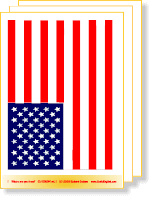 使用表現(target phrase):I want to go to Italy. Let's go.
使用表現(target phrase):I want to go to Italy. Let's go.
第一時:世界には様々な地域で話される英語があることを知る。
Hour One: Learn that English is spoken differently in different places.
![]() Where are you from? Theme
Where are you from? Theme
第二時:行きたい国とその理由について聞き、概要を理解する。
Hour Two: Listen to which country (someone) wants to go to and roughly
understand the reason.
![]() Create a country Game
Create a country Game
![]() Shapes BRAZIL Green, yellow, blue and white. A circle and a diamond in the center. This is Brazil. CHINA Red and yellow. One big star and four small stars. This is China.
Shapes BRAZIL Green, yellow, blue and white. A circle and a diamond in the center. This is Brazil. CHINA Red and yellow. One big star and four small stars. This is China.
![]() Around the world trip
Around the world trip
第三時:行きたい国を尋ねたり答えたりする。
Hour three: Ask and answer which country you would like to go to.
第四時:行きたい国を理由とともに言ったり、相手の行きたい国と理由とを理解したりする。
Hour Four: Say what country you want to go to and why. Understand when
a partner does the same.
※ This has to be the trickiest lesson to do. It's difficult to get the
kids to choose and it's difficult to give reasons without creating too
many stereotypes. In the example they use they say "I want to go
to Italy" and have picture of pizza and football. Maybe asking around
the embassies will help with materials for this class or if you have any
ideas then please add them at the end of this page!
Lesson 7 自分の一日を紹介しよう Introduce your day
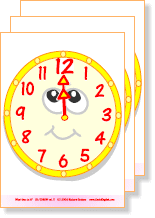 使用表現(target phrase):What time do you get up? At 7:00. I go to bed at 9:00.
使用表現(target phrase):What time do you get up? At 7:00. I go to bed at 9:00.
第一時:地球には時差があることを知るとともに、時間についての表現を知る。
Hour One: Learn that there are time differences in the world. Learn phrases about time.
![]() What time is it?とWhat time is it? Part2
What time is it?とWhat time is it? Part2
第二時:先生の一日の生活について話された内容を理解する。
Hour Two: Understand as the teacher talks about their day.
第三時:自分の生活に関する表(生活表)を作成する。
Hour Three: Make a "table" of the things you do each day.
第四時:作成した生活表をもとに、自分の一日を紹介する。
Hour Four: Using the list introduce your day (to the class.)
※Although many of the previous themes seem to take too much time over too
simple English, I think in this case it might be the other way round.
Lesson 8 オリジナルの劇を創ろう Make an original drama
使用表現(target English):Please help me. What's the matter?
第一時:世界には様々な民話や物語があることを知り、それらを興味を持って聞こうとする。
Hour One: Learn that there are different folktales around the world. Try
to listen with interest (that's what it says!).
第二時:「大きなカブ」の面白さを知り、グループで登場人物を変え、オリジナル「おおきなカブ」を作る。
Hour Two: Learn how interesting the story of the "Big Turnip"
is. Change the characters who appear in the story and make your own "Big
Turnip" story.
第三時:グループでオリジナルの物語を創作し劇の練習をする。
Hour Three: In groups make a play out of your original story
第四時:オリジナル物語を発表したり、他のグループの発表を聞いて理解したりする。
Hour Four: Present your story, understand other groups' stories.
※ Just make sure the teachers choose a good English version of the "Big
Turnip" story, some of the ones on sale in Japan look like they were
translated using google's automatic translation tool!
Lesson 9 将来の夢を紹介しよう - Introduce your future dreams
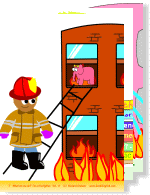
使用表現(target phrase):What do you want to be? I want to be a cook.
第一時:様々な職業の言い方を知る。
Hour One: Learn different job names.
![]() What do you want to be?
What do you want to be?
![]() What do you do?
What do you do?
第二時:将来就きたい職業について話されていることを理解する。
Hour Two: Understand when people talk about what they want to be.
第三時:将来就きたい職業について、尋ねたり答えたりする。
Hour Three: Ask and reply to what you want to be when you grow up.
第四時:スピーチメモをもとに、理由を含め自分の夢を紹介する。
Hour Four. Using a "speech memo" ( I don't know what that is)
introduce what you want to be and why.
※Always a good topic this, and much needed in Japan! Think big dreams.
I'm not sure about all the English we'll need to teach the reasons for
wanting to do a particular job. Maybe we could be super authentic and teach
the kids to just say "because". or "whatever"? (just
joking!)
Be genki,
Richard
Sign up to get my top tips, games & hints via email! |
 |
|---|
|
|